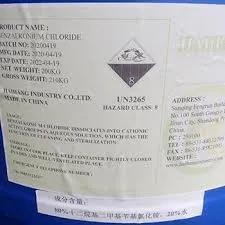pam chemical for water treatment
PAM Chemical for Water Treatment An Overview
Polyacrylamide (PAM) is a synthetic polymer widely used in various industrial applications, prominently in water treatment processes. Its unique properties make it an effective flocculant, coagulant, and thickening agent, contributing significantly to environmental protection and sustainable practices. As water scarcity becomes increasingly pressing, the utilization of PAM in water treatment processes is essential for enhancing water quality and ensuring safe drinking supplies.
PAM Chemical for Water Treatment An Overview
One of the primary applications of PAM in water treatment is in the coagulation and flocculation processes. When used in conjunction with traditional coagulants, PAM enhances the efficiency of these processes. Traditional coagulants, such as alum or ferric chloride, destabilize suspensions by neutralizing the charges on particles. PAM acts as a bridging agent, connecting these destabilized particles, facilitating the formation of larger aggregates that settle more readily. This synergy not only improves the overall effectiveness of the treatment process but also reduces the volume of coagulant required, minimizing costs and potential environmental impacts.
pam chemical for water treatment

In addition to drinking water treatment, PAM is also employed in wastewater treatment facilities. The polymer's ability to separate solids from liquids is invaluable in this context, as it aids in the removal of sediments, organic matter, and other contaminants. As industries face increasing regulatory pressures to treat effluents before discharge, the implementation of PAM in wastewater treatment systems has become more prevalent. Its use supports compliance with environmental standards and helps in the recovery of valuable resources, such as water and sludge, which can be reused or repurposed.
Another noteworthy aspect of PAM is its versatility. It can be tailored to meet specific needs by adjusting the molecular weight and charge properties, allowing it to function effectively across a wide range of water qualities and treatment scenarios. This adaptability makes PAM suitable for various applications, from municipal water treatment to industrial processes, ensuring its continued relevance in the field of water management.
Despite its many advantages, the use of PAM in water treatment is not without challenges. Concerns regarding the potential toxicity of polyacrylamide and its residuals in treated water necessitate rigorous monitoring and research. However, ongoing advancements in technology and methodology are aimed at mitigating these risks, promoting the responsible use of PAM in water treatment.
In conclusion, PAM plays a crucial role in modern water treatment processes, enhancing the quality and safety of water supplies while supporting sustainable practices. As water treatment needs grow more complex, the continued exploration of PAM’s capabilities and its integration into treatment protocols will be essential for addressing global water challenges efficiently. By leveraging the benefits of PAM, we can work towards cleaner, safer water for all.
-
lk-319-special-scale-and-corrosion-inhibitor-for-steel-plants-advanced-solutions-for-industrial-water-systemsNewsAug.22,2025
-
flocculant-water-treatment-essential-chemical-solutions-for-purification-processesNewsAug.22,2025
-
isothiazolinones-versatile-microbial-control-agents-for-industrial-and-consumer-applicationsNewsAug.22,2025
-
scale-inhibitor-key-solutions-for-water-system-scale-preventionNewsAug.22,2025
-
organophosphonates-versatile-scale-inhibitors-for-industrial-water-systemsNewsAug.22,2025
-
scale-and-corrosion-inhibitor-essential-chemical-solutions-for-water-system-maintenanceNewsAug.22,2025





